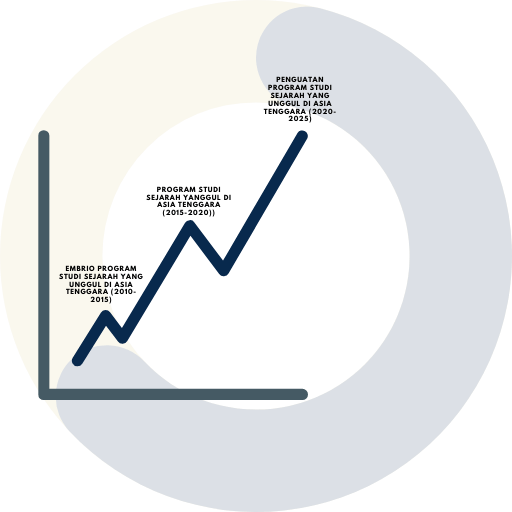Goals and Strategies
Goals
- Produces Bachelor’s Degrees in History and Culture, particularly on Maritime History and Culture with Moral Integrity and Scientific Attitude.
- Produces Bachelor’s Degrees in History and Culture, particularly on History and Maritime Culture who are able to be critical towards the nation’s actual problems from a historical perspective.
- Produces Bachelor’s Degrees in History and Culture, particularly on History and Maritime Culture who have the ability in historical research and communicate their expertise both oral and written.
- Produces Bachelor’s Degrees in History and Culture, particularly on History and Maritime Culture who have the ability to conduct documentation, publication, dissemination of scientific activities through collaboration and development of cooperation.
ACHIEVEMENT STRATEGIES
Based on the vision, mission, and goals, the objectives in the learning process in the Bachelor of History Study Program include the following aspects.
A. Increasing the relevancy to improve the quality of graduates and their absorption of graduates in the world of work, which is conducted through:
- Improving curriculum implementation which is regularly updated in accordance with community development by referring to the main and additional competencies, as mentioned in vision, mission, and objectives of the study program;
- Providing graduates with better knowledge, skills, and entrepreneurship.
- Improving information and communication service facilities
- Organizing workshops, training, seminars, and others.
- Developing the quality assurance system and its implementation methods.
B. Improving the Academic Atmosphere, which is conducted through:
- Improving the quality of the relationship between lecturers, educational staff, and students to support the activities of the Tridharma of Higher Education;
- Organizing regular discussions once every semester;
- Conducting research with lecturers and students;
- Improving library services;
- Creating a conducive working atmosphere.
C. Improving Institutional and Organizational Management, which is conducted through:
- Increasing productivity of faculty and university assets which is oriented towards creating added value;
- Improving quality of an integrated information system for internal management and cooperation with external parties;
- Increasing motivation and performance of lecturers and education staff;
- Improving planning and budgeting system based on a priority scale;
- Improving internal monitoring and evaluation systems;
- Improving the decision-making system and use of resources in a transparent, effective, and efficient way.
D. Improving Sustainability, which is conducted through:
- Increasing existence of institutions (amount of operational funds obtained from the community and government), quality assurance, and existing resources;
- Increasing both quantity and quality of community service which is oriented to the needs of the community and in accordance with the capabilities of the resources owned by the study program;
- Increasing community empowerment activities and alumni participation;
- Conducting activities which bring benefits to the study program through collaboration with other parties.
E. Improving Efficiency, which is conducted through:
- Optimizing the use of physical facilities and human resource competencies;
- Achieving significant acceleration of study period and thesis completion through improving the performance of supervisors.
F. Improving Leadership, which is conducted through:
- Implementing decision-making mechanisms in accordance with the four pillars of the new university paradigm (evaluation, accreditation, accountability, and autonomy);
- Establishing and developing peer groups to formulate dynamic and accountable organizational structure. Moreover, has a clear vision for institutional development;
- Organizing higher education management training for managers.
G. Improving Eligibility, which is conducted through:
- Entrance selection in accordance with the standards set by the university;
- Improving quality of learning process in accordance with the academic regulations of faculties and universities;
- Adjusting vision, mission, and objectives of the study program in accordance with the vision, mission, and goals of faculty and university.
- Improving the quality of the assurance system regularly.
H. Improving Sustainability, which is conducted through:
- Adjusting study program performance to the legal demands set by the government and universities;
- Networking ideas and needs of stakeholders as material for the implementation of the Tridharma of Higher Education activities.
I. Improving Selectivity, which is conducted through:
- Improving facilities and infrastructure as well as opportunities for the academic community to examine various issues related to excellence programs by the study program;
- Making further cooperation with institutions to develop the basic and additional competencies determined by the study program.
J. Improving Equity which refers to equal opportunity to get education is conducted through:
- Socialization of study programs to all levels of society;
- Providing scholarships for underprivileged students.
K. Improving Effectiveness, which is conducted through:
- Managing budget efficiently and appropriately in accordance with inputs and processes;
- Increasing motivation and performance of lecturers and education staff;
- Improving planning and budgeting systems based on a priority scale.
- Improving internal monitoring and evaluation systems;
- Improving decision-making systems and resource management in a transparent, effective, and efficient manner.
L. Increased Productivity, which is conducted through:
- Increasing productivity of university assets in use and value-added.
- Improving the quality of an integrated information system for internal management and cooperation with external parties;
- Improving student achievement and preventing dropout.
In 2002, the Department of History, Faculty of Letters, UNDIP, prepared a Development Strategic Plan (Renstra) focused on internal management. The development is a five-year development plan consisting of Short Term Programs (1998-2002), Medium Term (2003-2007), and Long Term (2008-2012). The Short Term Program includes programs for the development of internal management, particularly on human resource development. The Medium Term Program is the stage of institutional development by establishing a Master Program of History. The Long-Term Program, among others, is realized in the form of strengthening the institution by establishing a Doctoral Study Program of History and developing research and international publications.
In 2012, Faculty of Humanities, UNDIP has completed Faculty Strategic Plan, as manifested by four phases, namely Phase I (2005-2010), Phase II (2010-2015), Phase III (2015-2020), and Phase IV (2020-2025). Phase I is preparation as a research faculty. Phase II is the embryo of the research faculty. Phase III is the stage to be a research faculty, and Phase IV is a strengthening phase as a research faculty. In order to achieve vision, mission, goals and objectives, based on the Faculty of Humanities UNDIP Strategic Plan, the Bachelor of History has prepared the next development strategy (15 years) which is divided into three five-year development phases, namely Phase I (2010-2015), Phase II (2015). -2020), and Phase III (2020-2025) as shown in the graph.


